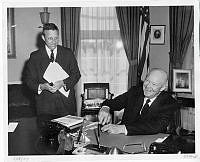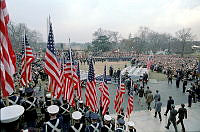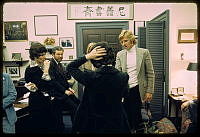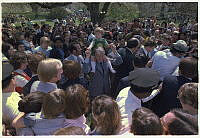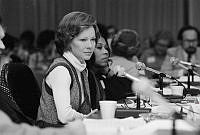The Locomotive Tea Set
A Gift from France
Copyright © Fall 2008 White House Historical Association. All rights reserved under international copyright conventions. No part of this article may be reproduced or utilized in any form or by any means, electronic or mechanical, including photocopying, recording, or by any information storage and retrieval system, without permission in writing from the publisher. Requests for reprint permissions should be addressed to books@whha.org

These drawings of the decorative locomotive-shaped teapot given to Jefferson Davis by France during the early years of the Civil War were printed in Frank Leslie’s Illustrated Weekly Newspaper in July 1866.
Library of CongressThe Statue of Liberty that stands in New York Harbor is surely the largest gift from France to this country. A smaller French gift arrived in Richmond during the early years of the Civil War, when the Confederate Capitol felt on top of the world—that the Confederacy might win the war. A decorative tea maker in the shape of a locomotive was presented to Jefferson Davis. Was it an official gift of the Second Empire and Napoleon III? No evidence has been found to support this notion, and it was more likely sent by someone hoping to establish business relations with the Confederate government, or perhaps it was only a wealthy admirer of President Davis. It was surely a unique and costly ornament that would brighten any room with its glossy china body and gilt hardware. It was displayed in the Confederate White House.
A rather sizable piece of tableware, it measures 23 inches long by 15 inches high by 7 inches wide. Technically it is not an accurate likeness of a real locomotive and appears to have been perhaps a manufactured pull-toy for children. Yet it has cylinders, a single pair of driving wheels, and a substantial smokestack. Most people would recognize it as a locomotive, which is likely about all the engine maker intended. The lack of a cowcatcher, headlight, and other American features suggest that the prototype was European. The buffers on the engine and tender confirm this supposition. From a decorative perspective it was splendidly customized, with elegant scrolls, lettering, banners, and flags. A panel on the side of the boiler is inscribed “President Jefferson Davis.” On the front of the boiler or smoke-box, the top banner reads “Confederate States of America.” The Confederate flag and its battle flag are entwined with the French national insignia. Just below the flags is another banner lettered in Latin with the familiar motto: “God helps those who help themselves.”
Mechanically, the tea maker was a simple device. The smoke stack was the hopper for the tea leaves; a loose-fitting cap could be lifted up to make an opening. A glass tube served as a siphon to direct the hot water from the boiler to the tea hopper. Just behind the tube is a funnel-shaped opening with a china plug. This is where water is introduced into the boiler. Behind the water plug is a brass turn-cock that, when left open, will indicate when the water is at a boil. The little platform behind the boiler once supported the china figure of an engineer or fireman ringing a huge dinner bell. Below the boiler on a sheet metal platform is a small spirit or alcohol lamp that keeps the water hot. A spigot at the very front of the locomotive delivers brewed tea to a cup or glass.
The tender is the small four-wheel car just behind the locomotive. When new it had several small cut-glass tumblers inside the railing now occupied by two large china cups. A cognac decanter fit just behind the tumblers. At the rear a china tea decanter may also have served as a sugar bowl. Below this rectangular container is a music box that could play eight popular tunes of the day. This mechanism no longer plays, but it is likely “Dixie” was one of those airs. Six hoops on each side of the tender were arranged to hold cigars.
A Richmond newspaper for April 17, 1865, reported on the sale of the locomotive tea set to an Italian named A. Barratti. Within a few days he resold it to Colonel Friedman of Philadelphia, who intended to give it to President Abraham Lincoln as a souvenir of war. Lincoln did not live to receive the intended gift. Friedman presented it to Andrew Johnson instead.
We assume Davis and his family were pleased with this delightful and decorative breakfast room novelty. Surely it became a plaything for the grandchildren. By the spring of 1865 there was little feeling for play or merriment in Richmond as the Union Army put an end to the Confederacy. Davis packed hurriedly to escape from the doomed capital. Much was left behind and consigned to Bell, Ellett & Company’s auction house on Pearl Street. A Richmond newspaper for April 17, 1865, reported on the sale of the locomotive tea set to an Italian named A. Barratti.1 Within a few days he resold it to Colonel Friedman of Philadelphia, who intended to give it to President Abraham Lincoln as a souvenir of war. Lincoln did not live to receive the intended gift. Friedman presented it to Andrew Johnson instead. Ironically, the china tea server went from the Confederate executive mansion to the U.S. White House.
Johnson was inaugurated as the seventeenth president upon Lincoln’s death and should have by rights occupied the White House on becoming the commander in chief. But he took pity on Mrs. Lincoln’s state of near-total collapse and advised her to remain in the Executive Mansion so long as it suited her needs. Meanwhile, Johnson was invited to share the apartment of Treasury Secretary Hugh McCulloch in the Treasury Department Building, which stood next to the White House. Johnson was a southerner and McCulloch born a New England Yankee, but the men got along famously. Each day during Johnson’s long exile they shared tea together, made in the locomotive tea maker. When Sir Frederick Bruce presented President Johnson his credentials as the British envoy, tea was served from the Davis tea urn. After Johnson took up residency in the White House, the tea server was placed in the library on the second floor as a display piece but was no longer used.
Few presidents had a more miserable time in office than Johnson. When his term was over in the spring of 1869, he was surely ready to return to his home in Greeneville, Tennessee. The china and gilt tea maker was among the objects returned to his eastern Tennessee home. It was passed down through succeeding generations and became the property of his great-great granddaughter, Mrs. Margaret P. Bartlett. She was a graduate of the local school, Tusculum College, in 1924, and was devoted to preserving papers and artifacts associated with her illustrious ancestor. Tusculum eventually became the repository for the Johnson papers. Mrs. Bartlett also attempted in other ways to keep his memory alive. In the fall of 1959 she visited First Lady Mamie Eisenhower in the White House and brought the tea locomotive with her.
The tea maker was loaned to the Treasury Department for display after the visit. A short article in the Washington Post alerted curators at the Smithsonian Institution that this national treasure was on exhibit just blocks away.2 W. E. Washburn, then chief of the Political History Division, made contact with Mrs. Bartlett. After a year of negotiations, the tea maker was lent to the Smithsonian. I remember it being on exhibit in the original First Ladies Hall in the Arts and Industries Building, which was one of the first modern galleries in this branch of the Smithsonian. In about 1964 the First Ladies Hall and all associated specimens were moved to the Museum of History and Technology, now renamed the National Museum of American History. In 1982, Mrs. Bartlett recalled the loan, and the Davis tea maker returned to Greeneville. Perhaps she wanted the relic near at hand in her advanced years. Mrs. Bartlett considered lending it to the World’s Fair in nearby Knoxville, but it is uncertain if that loan was ever honored. Sometime in the 1990s the tea maker joined the other Andrew Johnson memorabilia in the Tusculum College archives, where it remains to the present time.








